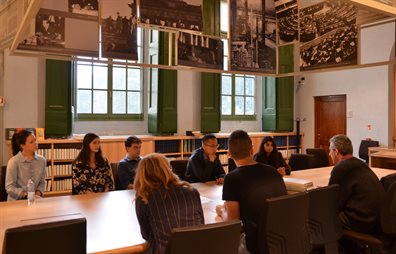Posted on 31 March 2015
 On Thursday 4th March seven students from NYU Florence visited Villa Salviati as part of their course on European integration and the origins of the Union. The session started with a brief introduction on the creation of the Historical Archives of the European Union (HAEU), its mission and the main fonds and institutional collections that are held in its deposits.
On Thursday 4th March seven students from NYU Florence visited Villa Salviati as part of their course on European integration and the origins of the Union. The session started with a brief introduction on the creation of the Historical Archives of the European Union (HAEU), its mission and the main fonds and institutional collections that are held in its deposits.
Students had the chance to consult some specific documents from the Alcide De Gasperi and Franco Maria Malfatti fonds regarding European History and the origins of its main institutions. The Alcide De Gasperi fond offers an unprecedented perspective on Italian history in the first part of the 20th Century and the origins of the European Union. The historical papers of De Gasperi are available for consultation at the HAEU since 2014. Meanwhile, the Franco Maria Malfatti fond illustrates his activities and decisions during his term as President of the EEC Commission in Brussels.
The communications and meetings between the Union and countries like China and the United States, part of the European Commission fonds, enabled the students with the assistance of the HAEU archivists to have a grasp on the historical events and decisions they have learnt during the past months at the Florence branch of the New York University. During the session they also paid special attention to official dossiers related to the adhesion of Great Britain, Ireland and Denmark to the European Union.
Their professor, Giorgia Giovannetti, stated the students’ enthusiasm after accessing these documents. “They were very impressed by the predominant role of French and English as conductors of the language of diplomacy at that time”, she said. Likewise, they remained fascinated by the possibility of reading some grey literature from the fonds of Tommaso Padoa Schioppa about important economic issues, such as the process for the introduction of the Euro as European currency.